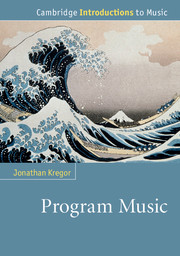Book contents
- Frontmatter
- Contents
- List of Figures
- List of Music examples
- List of Tables
- Acknowledgments
- Note on the text
- Introduction
- Chapter 1 Characters, topics, and the programmatic battlefield
- Chapter 2 Expression, musical painting, and the concert overture
- Chapter 3 Berlioz and Schumann on music and literature
- Chapter 4 Liszt and the symphonic poem
- Chapter 5 The New German School and beyond
- Chapter 6 Excursus: Faust
- Chapter 7 Programmatic paths around the fin de siècle: Mahler and Strauss
- Chapter 8 Programming the nation
- Chapter 9 “Ars Gallica”
- Notes
- Guide to further reading
- Index
Chapter 7 - Programmatic paths around the fin de siècle: Mahler and Strauss
Published online by Cambridge University Press: 05 January 2015
- Frontmatter
- Contents
- List of Figures
- List of Music examples
- List of Tables
- Acknowledgments
- Note on the text
- Introduction
- Chapter 1 Characters, topics, and the programmatic battlefield
- Chapter 2 Expression, musical painting, and the concert overture
- Chapter 3 Berlioz and Schumann on music and literature
- Chapter 4 Liszt and the symphonic poem
- Chapter 5 The New German School and beyond
- Chapter 6 Excursus: Faust
- Chapter 7 Programmatic paths around the fin de siècle: Mahler and Strauss
- Chapter 8 Programming the nation
- Chapter 9 “Ars Gallica”
- Notes
- Guide to further reading
- Index
Summary
Writing of the contemporary Austro-German musical landscape in 1912, the Munich-based critic and theorist Rudolf Louis posited three competing tendencies among composers of instrumental music: “the first, program-musical tendency leads via Berlioz and Liszt to Richard Strauss; the second, diametrically opposed direction leads via Schumann to Max Reger; and the third, which in a certain sense mediates between them, leads to Gustav Mahler.”
Louis’s valiant efforts in creating a stylistic taxonomy of music fall short vis-à-vis program music. His Strauss–Reger–Mahler trichotomy seeks to extend the philosophical divisions of the 1850s, which, as Chapter 5 contends, were at best practiced inconsistently by composers who often fled from one camp to the other – a situation perhaps implicitly acknowledged by Louis, who enlists Schumann on Reger’s behalf. Similarly, none of the contemporary composers mentioned by Louis (including Mahler, who had recently died) can be confined to any single category. Even Strauss, the public face of program music by the century’s end, routinely equivocated on the degree to which his music should assert programmatic agendas. Perhaps the single element that binds together composers active around the fin de siècle is an uneasy sense of place in history, for their compositions are as much about breaking away from tradition as they are about maintaining it.
- Type
- Chapter
- Information
- Program Music , pp. 195 - 226Publisher: Cambridge University PressPrint publication year: 2015



